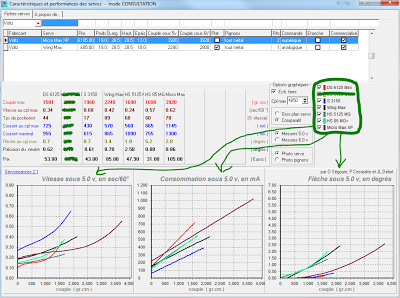First, a bit of background: the flap servos in my Sting needed replacing, but instead of purchasing a new set of 5125's, I decided to look for alternative units with stronger gears and more consistent centering. It boiled down to two choices, the Futaba 3150 (safe choice, but thicker) and the MKS 6125 Mini.
In the end, I chose the MKS 6125 Mini because (a) it had similar dimensions to the existing Hitec 5125 and (b) several F3F pilots were already using then and liked them.
Dimensions compared
The key features of the MKS 6125 Mini are the CNC milled aluminium case, and chrome titanium gears. The servo is the same width (10mm) and depth as the Hitec 5125, but slightly shorter. |
| Hitec 5125 (before) and MKS 6125 Mini (after). Note improved linkage geometry of the MKS installation. |
The MKS 6125 Mini is rated at either 5.5V or 6V depending on which label you're looking at. Either way, MKS imply that it can be powered by a 4-cell NiMH pack directly. If using a 5-cell NiMH or 2S Lipo, then a regulator must be used - unless you want to void the warranty. Conveniently, MKS offer an 'SBEC' regulator which connects inline with each servo.
Retrofitting the MKS 6125
If your existing servos are Hitec 5125's, then it may well be possible to retrofit the MKS 6125 Mini's using your existing servo trays, although a small piece of ply will be needed to support the bottom lug.In my case, however, I needed to reposition the servos as I wanted to improve the linkage geometry. This meant that I had no option but to remove the existing servo trays, and unfortunately these were epoxied very firmly to the wing skin.
I agonised about how to remove the trays without damaging the wing, until fellow F3F'er Keith Wood suggested a direct approach, using a chisel. I modified his technique slightly, by adding a hammer!
Hammer and chisel
Using a hammer and chisel to remove a servo tray from a moulded wing may sound like total madness, but it actually worked very well. The secret was not to force or rush things, to chisel small pieces at a time, and to apply any force only along the wing axis. It's important to keep the chisel really sharp, and I kept an oilstone handy for this purpose.To prevent the wing panel moving under the hammer blows, I placed a brick against one end of the wing with some neoprene padding to absorb the shock.
 |
| Tools for removing the old plywood servo tray (clockwise from top left): house brick, foam bed, chisel, hammer, oilstone. |
It took a couple of hours to hack out the old trays. To my great relief, the wing skin remained unmarked.
All that remained was to cut some new trays, glue them into the space, and screw in the 6125 Mini's. One last point... the mounting screws which MKS supply are quite large diameter, in fact they barely pass through the servo lugs. To avoid splitting the ply, I substituted some narrower diameter screws.
Performance of MKS 6125 v. Hitec 5125
Mechanically, the MKS 6125 Mini is very nice indeed - the gears are smooth and quiet, there's virtually no slop, and they are fast.Impressions are one thing, but there's no substitute for actual figures. Fortunately the guys at Servomances have tested a large number of different servos, with the results available on a downloadable database. I used it to compare the following servos: MKS 6125 Mini, Hitec 5125, Futaba 3150, Volz WingMaxx, Volz MicroMaxx XP, and Hitec 85 MG:
 |
| Comparison of popular wing servos (from Servomances) |
Translations:
Couple = torque
Vitesse = speed
Courant = current
Fleche = deflection
Prix = price
The 6125 Mini has higher current drain than the Hitecs, and the difference becomes greater under load. This is something worth bearing in mind especially if using a full complement of four servos. It also suggests that bias loads on the control surfaces should be minimised through careful linkage design and by using free moving hinges.
Of academic interest is the performance of the Volz MicroMaxx XP, clearly a very powerful and efficient servo in spite of being an obsolete design.
Summary
Overall, I'm very pleased with the MKS 6125 Minis - they aren't cheap, but they are a worthwhile step up from the Hitec 5125.
So far I have only installed them for the flaps, but their high speed makes them a good choice for ailerons as well. In fact, a combination of MKS 6125 Mini's for ailerons, and slower but low-drain Futaba 3150's for flaps would make a good cost-effective setup, especially if running with four cells.
So far I have only installed them for the flaps, but their high speed makes them a good choice for ailerons as well. In fact, a combination of MKS 6125 Mini's for ailerons, and slower but low-drain Futaba 3150's for flaps would make a good cost-effective setup, especially if running with four cells.
For thin wings, a set of four MKS 6125 Mini's would be a fine choice. Make sure your battery can deliver the necessary current while maintaining a stable voltage - if necessary go for a higher voltage battery (5 cell NiMH or 2-cell LiPo) but remember that if you use the higher voltages, then it's essential to use a regulator, preferably an SBEC on each servo.
My MKS 6125 Mini's were maidened at the recent North of England Open F3F competition, and performed very well - and for once the flaps centred perfectly every time!
No comments:
Post a Comment